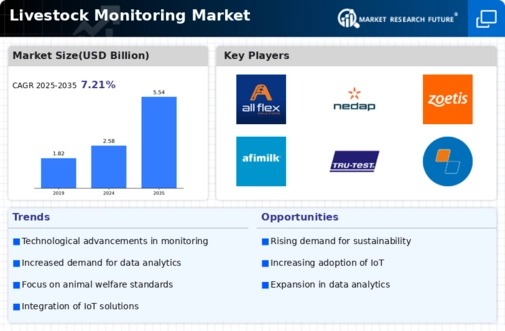Rising Demand for Animal Protein
The Global Livestock Monitoring Market Industry is significantly influenced by the rising demand for animal protein, driven by population growth and changing dietary preferences. As consumers increasingly seek high-quality meat and dairy products, livestock producers are compelled to enhance their operational efficiency. Monitoring systems play a crucial role in optimizing feed conversion rates and improving animal health, thereby ensuring sustainable production. This trend is expected to contribute to the market's growth, with projections indicating a rise to 5.54 USD Billion by 2035. Consequently, the need for effective livestock monitoring solutions becomes paramount to meet the escalating demand.
Government Initiatives and Support
Government initiatives aimed at promoting sustainable agriculture practices bolster the Global Livestock Monitoring Market Industry. Various countries implement policies that encourage the adoption of advanced livestock management technologies, providing financial incentives and subsidies to farmers. For example, initiatives focused on reducing greenhouse gas emissions from livestock operations often include provisions for monitoring systems that enhance efficiency. Such support not only aids farmers in improving productivity but also aligns with global sustainability goals. As a result, the market is likely to witness robust growth, driven by these supportive frameworks and the increasing emphasis on sustainable livestock farming.
Increasing Awareness of Animal Welfare
The Global Livestock Monitoring Market Industry is also shaped by the growing awareness of animal welfare among consumers and producers alike. As ethical considerations gain prominence, livestock producers are adopting monitoring systems to ensure the well-being of their animals. These systems provide insights into animal behavior, health, and living conditions, enabling farmers to address welfare concerns effectively. The demand for transparency in livestock production is likely to drive the adoption of these technologies, as consumers increasingly prefer products sourced from farms that prioritize animal welfare. This trend may further accelerate market growth as stakeholders recognize the importance of ethical practices.
Technological Advancements in Livestock Monitoring
The Global Livestock Monitoring Market Industry experiences a surge in technological advancements, particularly in IoT and AI applications. These innovations facilitate real-time monitoring of livestock health, behavior, and location, enhancing productivity and reducing losses. For instance, smart collars equipped with GPS and health sensors provide farmers with critical data, enabling proactive management. The market is projected to reach 2.58 USD Billion in 2024, reflecting the growing adoption of these technologies. As farmers increasingly rely on data-driven decisions, the integration of advanced monitoring systems is likely to become a standard practice in livestock management.
Integration of Data Analytics in Livestock Management
The integration of data analytics into livestock management significantly impacts the Global Livestock Monitoring Market Industry. By leveraging big data, farmers can analyze trends and patterns related to animal health, feed efficiency, and overall productivity. This analytical approach allows for informed decision-making, ultimately leading to enhanced operational efficiency and profitability. As the market evolves, the adoption of data-driven strategies is expected to grow, with a projected CAGR of 7.2% from 2025 to 2035. Consequently, the emphasis on data analytics in livestock monitoring systems is likely to reshape industry practices and drive future innovations.





















